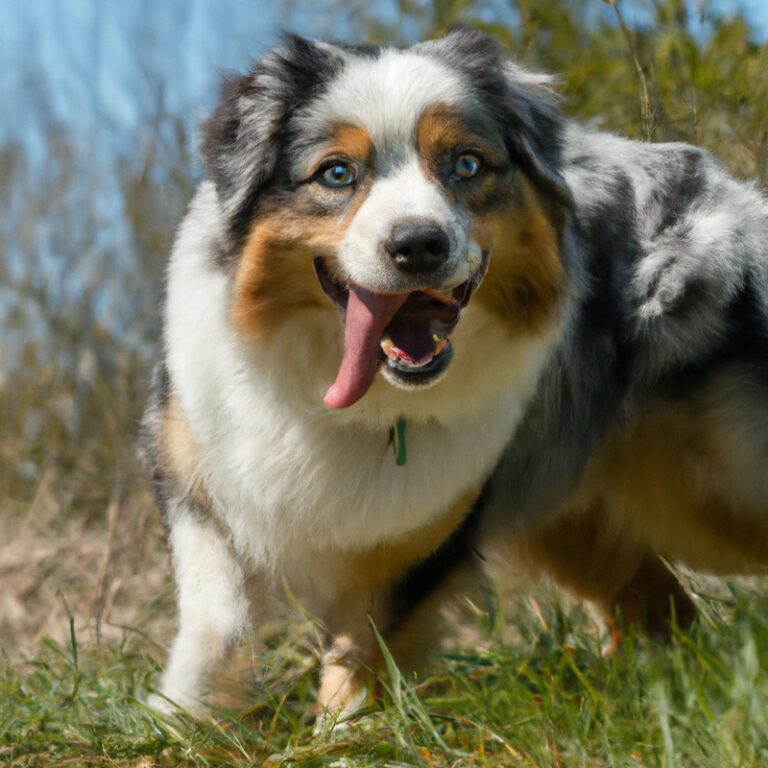How Do Australian Shepherds Interact With Other Dogs At The Park?
Key Takeaways:
- Australian Shepherds have a generally friendly and sociable nature towards other dogs at the park.
- They tend to be playful and enjoy forming strong bonds with other dogs.
- Australian Shepherds have a herding instinct, which can sometimes be observed during interactions with other dogs.
- Proper socialization and training are essential to ensure positive interactions with other dogs at the park.
Are you curious to know how Australian Shepherds, those energetic and playful furballs, interact with other dogs at the park? Well, as an experienced dog lover and owner, let me tell you, it’s a delight to watch these intelligent and social creatures in action! With their natural herding instinct and abundance of energy, Australian Shepherds have a unique way of making friends and navigating the doggy social scene.
In this article, I’ll dive into their temperament, socialization techniques, and training tips to help you ensure a positive experience for your Australian Shepherd and their furry pals at the park.
So, let’s get started!
| Interaction | Positive | Negative |
| Playfulness | Bounces and play bows | Could be rough if not managed |
| Socialization | Usually friendly and sociable | May exhibit fear or aggression if not properly socialized |
| Energy level | Thrives on energetic play | May overwhelm less energetic dogs |
| Communication | Clear body language and appropriate play signals | Can be pushy or dominant if not trained |
| Aggression | Generally non-aggressive | May react if provoked or feel threatened |
Understanding Australian Shepherds’ Temperament
Australian Shepherds’ Natural Herding Instinct
Australian Shepherds have a strong natural herding instinct. It’s in their DNA! This instinct drives them to gather and move livestock, like sheep or cattle.
Even if they’ve never herded anything in their lives, this instinct can still be evident in their behavior.
They may try to round up other dogs, or even children, at the park. It’s important to understand and manage this instinct to ensure a positive and safe experience for all.

Australian Shepherds’ Energy Levels
Australian Shepherds have high energy levels. They are an active and lively breed that requires plenty of exercise and mental stimulation.
I find it important to provide them with regular opportunities to burn off their energy.
This can include activities such as long walks, runs, hikes, and playing games like fetch or frisbee. Mental stimulation is also crucial for them, so I like to incorporate puzzle toys and training sessions into their routine.
Providing outlets for their energy helps keep them happy and prevents them from becoming bored or frustrated.

Introducing Australian Shepherds to Other Dogs
Socialization from an Early Age
Socialization from an early age is key to ensuring that Australian Shepherds develop good social skills and are comfortable around other dogs. It’s important to expose them to different environments, people, and animals in a positive way to help them become well-rounded and confident.
This can be done through puppy playdates, obedience classes, and regular outings to parks or dog-friendly places.
The more positive experiences they have, the better equipped they will be to interact with other dogs at the park.
Supervised Meetings and Controlled Environment
Supervised meetings and a controlled environment are key when introducing Australian Shepherds to other dogs at the park. It’s important to have a close eye on the interaction to ensure the safety and comfort of all dogs involved.
By supervising the meeting, I can step in if any signs of aggression or discomfort arise.
Additionally, a controlled environment allows me to set the pace and create a positive experience for both dogs. Knowing when to intervene and providing a safe space is crucial in successful introductions.
Signs of Healthy Interaction at the Park
Calm and Relaxed Body Language
When it comes to Australian Shepherds, calm and relaxed body language is a positive sign during interactions at the park. The way a dog holds its body can indicate its level of comfort and confidence.
Look for signs such as loose, wagging tail, relaxed facial expressions, and soft eyes.
The dog’s body should appear relaxed and not tense or stiff. This shows that the Australian Shepherd is enjoying the interaction and is likely to have a positive experience with other dogs.
So, keep an eye out for these calm and relaxed body language cues to ensure a healthy and enjoyable playtime for your furry friend.

Positive Play and Engagement
Positive play and engagement are essential for Australian Shepherds when interacting with other dogs at the park. During play, it’s important to observe positive behaviors such as wagging tails, loose body language, and frequent pauses for check-ins.
Engaging in games like fetch or tug-of-war can help dogs bond and release energy.
I encourage owners to actively participate in play sessions, using toys or treats as rewards for good behavior. Remember, positive play and engagement create an enjoyable and safe environment for all dogs involved.
Respect for Personal Boundaries
Respecting personal boundaries is essential when it comes to Australian Shepherds interacting with other dogs at the park. Dogs, just like humans, have their own comfort zones and personal space.
It is important to recognize and respect these boundaries to ensure a positive and safe experience for everyone involved.
Here are some tips for respecting personal boundaries:
- Give space: Allow each dog to have enough room to move freely and comfortably. Avoid crowding or getting too close to other dogs, especially if they show signs of discomfort or stress.
- Observe body language: Pay attention to the body language of both your Australian Shepherd and the other dogs. If either dog displays signs of fear, anxiety, or aggression, it is best to give them extra space and avoid any direct interactions.
- Allow sniffing introductions: Allowing a controlled sniffing introduction between dogs can help them establish a positive connection. However, always monitor the interaction and intervene if either dog becomes uncomfortable or aggressive.
- Ask for consent: If you notice that your Australian Shepherd wants to interact with another dog, always ask the owner for permission before allowing them to approach. Not all dogs are comfortable with unexpected greetings.
- Respect leash boundaries: Some dogs may be on a leash for various reasons, and it is crucial to respect their boundaries. Keep your Australian Shepherd under control while also allowing the leashed dog to feel safe and secure.
By respecting personal boundaries, you can create a harmonious and enjoyable environment for your Australian Shepherd and other dogs at the park. Remember, every dog is unique, and it is important to be observant and attentive to their individual comfort levels.
Dealing with Challenging Interactions
Recognizing Aggression or Discomfort Signs
Recognizing aggression or discomfort signs in Australian Shepherds is essential for ensuring a safe and enjoyable park experience. Here are some key signs to watch out for:
- Body Language: Look for stiff posture, raised hackles, or a tense facial expression. These signs indicate that a dog may be feeling threatened or aggressive.
- Growling or Snapping: Vocalizations like growling or snapping are clear signs of aggression. Dogs may exhibit these behaviors to establish boundaries or to communicate discomfort.
- Resource Guarding: If a dog becomes possessive over toys, food, or other objects, it can lead to aggressive behavior. Watch for signs of resource guarding, such as growling, stiff body language, or protective stance.
- Fearful Behavior: Dogs that cower, tuck their tails, or try to hide are displaying signs of fear or discomfort. It’s important to respect their boundaries and give them space.
- Lip Curling or Snarling: When a dog curls their lips or snarls, it’s a warning sign that they may escalate to more aggressive behavior if their discomfort is not addressed.
If you observe any of these signs, it’s important to intervene and separate the dogs to prevent any potential conflicts. Remember, every dog is unique, and it’s important to be mindful of their individual comfort levels and boundaries.
Steps to Diffuse Tension or Conflict
When tension arises between Australian Shepherds and other dogs at the park, it’s important to diffuse the situation to ensure the safety and well-being of all involved. Here are some steps you can take:
- Stay calm and composed: Your energy can affect the dogs around you, so remaining calm is essential.
- Distract and redirect: If you notice tension building, try redirecting the attention of the dogs involved by calling them away or engaging them in a different activity.
- Use positive reinforcement: Rewarding good behavior can help diffuse tension and encourage more positive interactions.
- Create distance: If necessary, create physical distance between the dogs by walking them in different directions or using a leash to separate them temporarily.
- Seek professional help if needed: If tension or conflict persists, it may be beneficial to consult a professional dog trainer or behaviorist for further guidance and support.
Training Tips for Better Park Interaction
Basic Commands for Recall and Obedience
When training an Australian Shepherd for better park interaction, it’s important to start with basic commands for recall and obedience. Teaching your dog these commands will help you keep them safe and under control at the park.
The first command to focus on is “come” or “here.” This command is crucial for recall, especially in situations where your dog may be distracted or tempted to run off.
Start by using a long leash in a controlled environment, and call your dog’s name followed by the command. Use treats or positive reinforcement to reward them when they come to you.
“Sit” is another fundamental command that can be helpful at the park.
It allows you to control your dog’s behavior and prevent them from approaching other dogs or people without permission. Practice this command by using treats and gently pushing their bottom down while saying “sit.” Gradually remove the physical prompt and reward them when they sit on command.
“Stay” is a command that will come in handy when you need your dog to remain in one place, either to avoid a potentially dangerous situation or to wait for your permission to approach another dog.
Start by asking your dog to sit, then extend your hand with an open palm in front of their face and say “stay.” Take a step back and reward them for staying in place. Gradually increase the distance and duration of the stay.
Lastly, “leave it” is an essential command for preventing your dog from picking up or approaching things that may be harmful or inappropriate.
Begin training by holding a treat in your closed hand and saying “leave it.” Wait for your dog to lose interest or back away, then reward them with a different treat. Repeat this exercise with various objects to reinforce the command.
Remember, consistency and positive reinforcement are key when teaching your Australian Shepherd these basic commands.
Practice in different environments and gradually increase distractions to ensure they respond reliably. By incorporating these commands into your training routine, you’ll have better control over your dog’s behavior at the park and create a safer and more enjoyable experience for everyone involved.
Reinforcing Good Behavior with Positive Rewards
To reinforce good behavior in Australian Shepherds at the park, positive rewards can be a highly effective tool. When your Aussie displays desirable behavior, such as following commands or playing nicely with other dogs, it’s important to provide them with positive reinforcement.
This can be in the form of praise, treats, or a favorite toy.
By consistently rewarding good behavior, you are encouraging your Aussie to continue behaving positively in the park. Remember to be consistent and use positive rewards immediately after the desired behavior occurs.
This will help your Australian Shepherd understand which behaviors are valued and will make their park interactions more enjoyable for everyone involved.
Maintaining Positive Experiences at the Park
Regular Exercise to Release Excess Energy
To ensure a positive experience for your Australian Shepherd at the park, regular exercise is key. These energetic dogs require plenty of physical activity to release their excess energy.
By providing daily exercise, such as walks, runs, or playtime, you can help prevent pent-up energy that may lead to frustration or unwanted behaviors.
Engaging your Australian Shepherd in activities that stimulate their body and mind will also promote their overall well-being. So, make sure to prioritize regular exercise for your furry friend to maintain a happy and balanced park experience.
Making Friends and forming a Routine
Making friends and forming a routine is essential for a positive experience at the park with your Australian Shepherd. To make friends, encourage your dog to interact with others through supervised playdates or group activities.
This helps them socialize and build confidence.
Forming a routine is also important. Set a schedule for park visits, allowing your dog to become familiar with regular outings.
This consistency helps them feel secure and reduces anxiety.
Additionally, having a routine ensures that your dog gets regular exercise and mental stimulation. By making friends and establishing a routine, you create a positive environment where your Australian Shepherd can enjoy the park to the fullest.
They will gain social skills, build relationships, and have a consistent and enriching experience.
Final Verdict
Australian Shepherds are typically social and friendly dogs, making them great companions at the park. Their natural herding instincts and high energy levels can sometimes require extra supervision and control during introductions, but with early socialization and a controlled environment, they can have healthy interactions with other dogs.
Look for signs of calm and relaxed body language, positive play and engagement, and respect for personal boundaries to ensure a positive experience.
If faced with challenging interactions, recognize aggression or discomfort signs and take steps to diffuse tension or conflict. Training Australian Shepherds with basic commands and positive reinforcement can also improve their park interactions.
To maintain positive experiences, regular exercise and forming a routine with friends can help release excess energy and build strong bonds.
By following these guidelines, both you and your Australian Shepherd can enjoy a rewarding and enjoyable time at the park.







